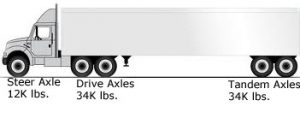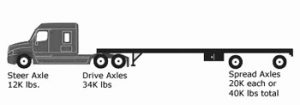Seasoned tractor-trailer drivers know intimately how weight distribution effects drivability, and axle spacing – namely spread axles versus double axles – plays a primary role in this. For those new to the arena of heavy trailer axles, however, confusion and assumptions abound. Which axle style is superior? The seasoned pros at Ainsworth Trailer Repair take a closer look…
Small Difference, Significant Effects
Though the axle spacing between the different axle configurations is obvious, the ramifications of this subtle shift are not:
- Tandem Axles
Rear axles spaced close together, usually about 5-feet apart. - Spread Axles
Axles spaced farther apart, about 10-feet.


Trailer Axle Spacing Effects Weight Distribution
Though the gross legal limit of either setup is 80,000-pounds, allowable weight distribution above each axle configuration is quite different.
Tandem Axles
12K+34K+34K=80K gross weight.

Spread Axles
12K+34K+20K+20K=86K (though gross max caps at 80K).

Trailer Axle Style: Which is Best?
As with many things, each axle style has its pros and cons…
- Tandem Axles: Terrific in Tight Spaces
The axles on tandem axle trailers can be slid forward or backward to adjust the amount of weight resting atop the axle. However, this can be quite the juggling act with heavier loads, making it difficult to get cargo weight correctly balanced – and right at the limit of 80,000-pounds. What tandem axles lack in maneuverability of cargo, however, they make up for in maneuverability on the road. They are much easier to handle on city streets, in tight spaces, and in reverse, as well as easier on tires. - Spread Axles: The Long-Haulers Friend
Offering 20,000=pounds above each axle, spread axles offer more flexibility in placing heavier cargo. Though capped at an 80,000-pound gross limit, the 86,000-pound legal limit offers a much more forgiving margin of error for heavy hauls and easier balancing on the scales. However, this flexibility comes at a price: Though spread axle trailers offer a smoother ride and better tracking in most situations due to their longer wheelbase, they are hard to maneuver on tight roads and crowded docks, presenting a greater degree of difficulty in turning and backing up. They are also tougher on tires, ‘scrubbing’ in turns (though this may be offset using the dump of the rear axle). Golden State hauler? California requires trailers longer than 48-feet have a kingpin in the center of the rear axle of 41-feet, meaning the rear axle would need to be scooted forward to be legal.
Trailer axle issues? No matter what trailer axle configuration you’re toting, you can count on the knowledgeable staff at Ainsworth Trailer Repair to do the necessary math to keep your rig running in tip-top shape. Guard against excess tire wear and ensure safety and fuel economy. Contact us and schedule a trailer axle inspection and alignment today.



